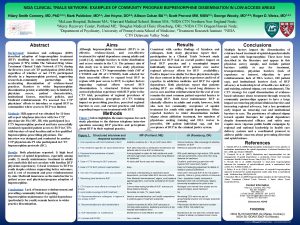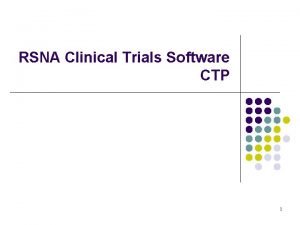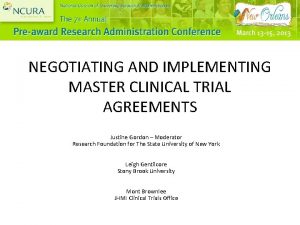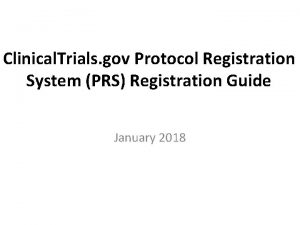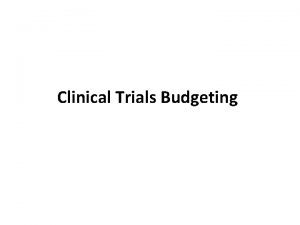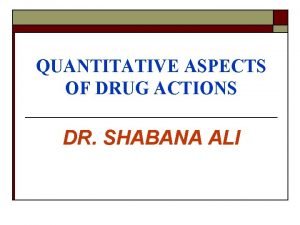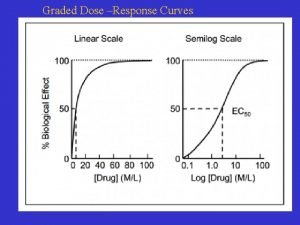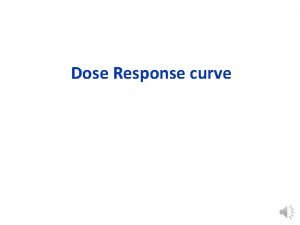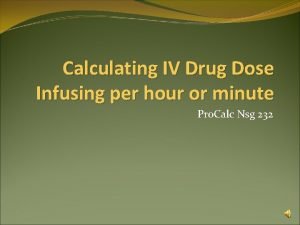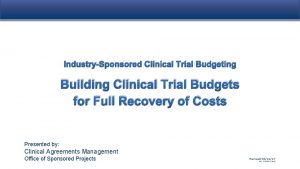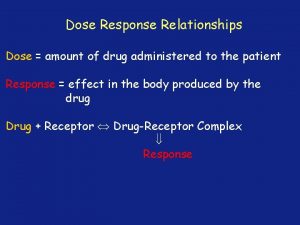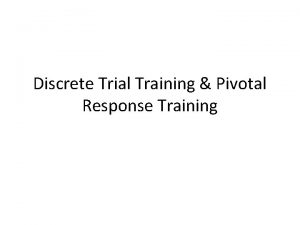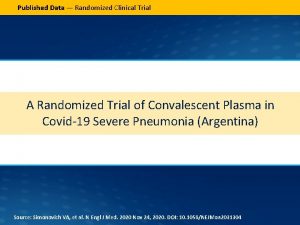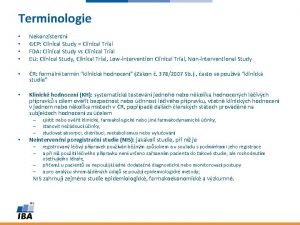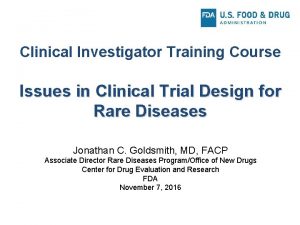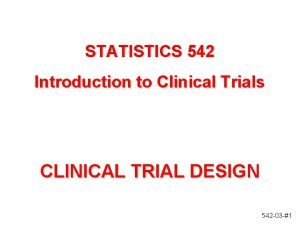DOSE SPACING IN EARLY DOSE RESPONSE CLINICAL TRIAL



























- Slides: 27

DOSE SPACING IN EARLY DOSE RESPONSE CLINICAL TRIAL DESIGNS Naitee Ting, Ph. D. Associate Director Pfizer Global Research & Development




STUDY 1 - WHAT’S NEXT?

STUDY 2


Questions in Designing the First Dose Response Study • How many doses to be tested? • What are the high and low doses? • What are the spaces between the test doses (what is the dose spacing)? • How frequent should subjects be dosed? • How many subjects for the study?

Dose Response Study Design • • Selection of control Selection of endpoints Fixed dose vs titration dose Two-stage designs vs Two designs

Dose Response Study Design • In early Phase II, drug first tested in patients • Assume maximum tolerable dose (MTD) known, assume monotonicity • Efficacy response, toxicity response • Range and spacing of doses

Limited Number of Fixed Doses • • Concerns in interpreting titration dose Multiple center designs Formulation considerations Placebo and maximum tolerable dose (MTD) • Incorporate active control?

Considerations in Dose Allocation • Selecting a wide range of doses • Find doses to capture the steepest increasing portion of efficacy dose response curve • Use of some low doses to help identify the minimum effective dose (Min. ED) • Not very high to be too close to MTD





Binary Dose Spacing • For 2 active doses, one above 1/2, one below • Continue with this fashion to the lower end • Any cut for 1/p, where p 2 • Non-parametric, model independent • Applies to titration design, sequential design, active control, early or late Phase

Compare to Optimal Designs • For a given model, optimal design allocate doses according to D-optimality • The most frequently used model is logistic • Another model is normal cdf (with parameters m and s)

Criteria for Comparison • Provide a steeper slope from placebo • Identify a minimum effective dose (Min. ED)

Simulation Procedure • Ten and fifty obs. generated from each dose • Each obs. is normal with mean from model and standard deviation of 0. 1 & 0. 025 • Slopes from placebo to each dose • Assuming minimum effect is 0. 2, Min. ED is obtained from lower 95% confidence limit

Table 1. Treatment Group Means, Slopes From Placebo To Each Dose, And 95% Confidence Limits From Simulated Data Under Different Sample Sizes And Standard Deviations Simulation based on Model: with 1 =1. 565 and 2 =4. 174 BDS doses: Low = 0. 125, Medium = 0. 375, High = 0. 750 Optimal doses: Low = 0. 082, Medium = 0. 375, High = 0. 668 n/group = 10 n/group = 50 std. dev. =0. 1 std. dev. =0. 25 BDS Opt. BDS Opt. Mean (Pcbo) 0. 1804 0. 1516 0. 1813 0. 1926 0. 1508 0. 1747 0. 1626 0. 1802 Mean (Low) 0. 2468 0. 2315 0. 3351 0. 2153 0. 2724 0. 2439 0. 2799 0. 1382 Lower L -0. 0153 -0. 0133 -0. 1039 -0. 2009 0. 0833 0. 0311 0. 0253 -0. 1420 Mean (Med) 0. 5223 0. 5533 0. 4792 0. 4787 0. 5133 0. 4995 0. 4834 0. 4883 Lower L 0. 2588 0. 2958 -0. 0451 0. 0652 0. 3261 0. 2829 0. 2230 0. 2173 Mean (High) 1. 8610 0. 7624 0. 8148 0. 8436 0. 8170 0. 7544 0. 7871 0. 8005 Lower L 0. 6068 0. 5111 0. 3679 0. 4890 0. 6292 0. 5350 0. 5164 0. 5266

Table 2. Simulation Results with 3 Active Doses Using a Logistic Model to Compare D-optimal Dose Spacing and Binary Dose Spacing of ½ distance 2 Low Medium High Overall Min. ED 1 2 2 2 2 3 3 3 3 4 4 4 4 6 8 10 12 14 16 18 B B B B O O O O O B B O O O O O B B B B B O O O O O O O O O O O BD 2 OP 2 BD 1 OP 2 BD 2 OP 2 OP 1 BD 1 OP 1 OP 1

Table 3. Simulation Results with 4 Active Doses Using a Normal Model to Compare D-optimal Dose Spacing and Binary Dose Spacing of ½ distance 1 2 Low Med. Hign Med. High Overall Min. ED. 0. 1 0. 2 0. 3 0. 4 0. 5 0. 6 0. 1 0. 2 0. 3 0. 4 0. 5 0. 1 0. 2 0. 3 0. 4 B O O O B O O B B B O O O O O B B B O O O O O O B O O O B B B O O O O O B B O O BD 1 OP 2 OP 1 BD 2 OP 1 OP 2 OP 1 BD 3

Table 4. Treatment Group Means, Slopes From Placebo To Each Dose, And 95% Confidence Limits From Simulated Data When The Underlying Model Is Mis-specified True Model: 1 =. 38 and 2 =. 32. Using optimal design, this model was mis-specified as 1 =. 32 and 2 =. 38 BDS doses: Low = 0. 125, Medium = 0. 375, High = 0. 750 Optimal doses (mis-specified model): Low = 0. 010, Medium = 0. 320, High = 0. 630 (the correct doses should be Low = 0. 119, Medium = 0. 380, High = 0. 641) Simulation performed with n=20 per group and std. dev. = 0. 25. BDS Dose Allocation Optimal Dose Allocation Point Lower L estimate Upper L Lower L estimate Upper L Mean (Pcbo) 0. 1123 0. 1976 Mean (Low) 0. 0675 0. 1958 0. 0021 0. 2141 Mean (Med) 0. 3648 0. 4955 0. 2865 0. 4997 Mean (High) 0. 7420 0. 8699 0. 5797 0. 7904 Slope Low 0. 540 0. 668 0. 796 0. 202 1. 575 2. 948 Slope Med 0. 973 1. 022 1. 071 0. 895 0. 944 0. 993 Slope High 0. 989 1. 010 1. 031 0. 921 0. 942 0. 962

Conclusion • Assume MTD known and monotonic relationship • Intuitive and with wide applications • Model independent approach vs parametric optimality - Not much of a comparison • A general recommendation, not one size fits all

Analysis of Dose Response Studies • • • Multiple comparison adjustment Placebo control, active control, or both Dunnett’s method, Step down method Linear, quadratic dose response Minimum effective dose (Min. ED)

Analysis of Dose Response Studies • • Drug safety in dose response studies Estimation vs hypothesis testing Exploratory vs confirmatory Analysis of the entire database
 Novel clinical drug trial design
Novel clinical drug trial design Accelerated clinical trial agreement acta
Accelerated clinical trial agreement acta Nida clinical trial network
Nida clinical trial network Iwr clinical trial
Iwr clinical trial Ctp dicom
Ctp dicom Master clinical trial agreements
Master clinical trial agreements Clinicaltrials.gov api
Clinicaltrials.gov api Mosaico clinical trial
Mosaico clinical trial Ivd clinical trial design
Ivd clinical trial design Morpheus clinical trial
Morpheus clinical trial Clinical trial matching service
Clinical trial matching service Clinical trial financial management
Clinical trial financial management Protocol registration system
Protocol registration system Clinical trial exports
Clinical trial exports Clinical trial budget example
Clinical trial budget example Nnz-2566
Nnz-2566 Uiris uiowa
Uiris uiowa Phase 4 trials
Phase 4 trials Clinical trial centers alliance
Clinical trial centers alliance Cynchia
Cynchia Clinical trial worksheet
Clinical trial worksheet Dose response curve apes definition
Dose response curve apes definition Graded dose response curve
Graded dose response curve Graded response curve
Graded response curve Pharmacodynamics
Pharmacodynamics Graded vs quantal dose response curve
Graded vs quantal dose response curve Graded dose response curve
Graded dose response curve Early cpr and early defibrillation can: *
Early cpr and early defibrillation can: *


